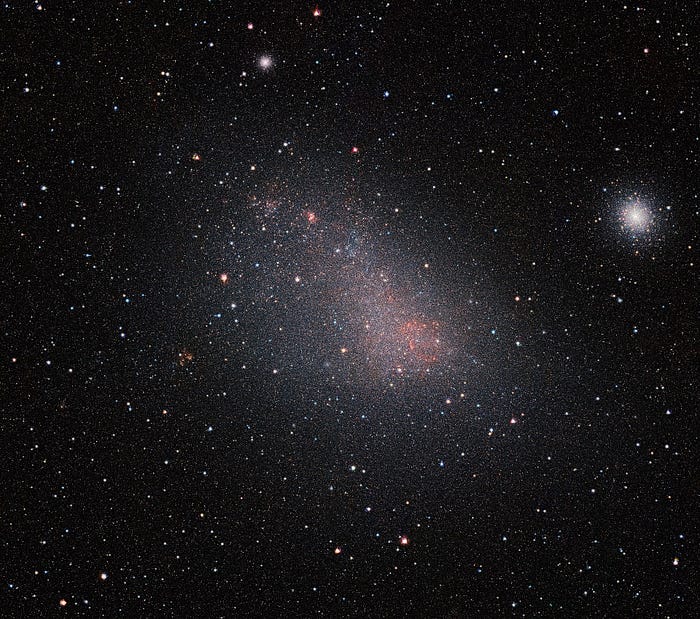The Cosmic Neighbours: Satellite galaxies of the Milky Way

We all are aware that our solar system is part of a galaxy called the Milky Way. A spiral galaxy with more than a 100 billion stars, Milky Way is second largest in the local group of galaxies which includes the M31 (Andromeda Galaxy, the largest) and M33 (Triangulum Galaxy).
Here is a thought that might occur in your minds — since stars attract each other with their gravity, which in turn keeps all galaxies intact, wouldn’t galaxies as a whole have their own gravitational force? Does that mean galaxies also attract other galaxies?
The answer, as most of you would expect, is yes! When I talked about local group of galaxies above, the three galaxies are actually forming a group with gravity keeping them together. There are many such galaxy groups in the entire universe. In fact, the gravitational attraction between the Andromeda galaxy and our Milky Way is such that in a few billion years they both will collide, with a possible collision with the Triangulum galaxy as well! Don’t worry, the solar system is predicted to survive this collision, however you’ll be long gone by then, so you can take it off your bucket list if you’re crazy enough to consider witnessing it.
Now that we have established gravitational force to exist for galaxies, it is just logical to believe that just like Earth is kept in orbit by the Sun, all galaxies can keep other (smaller) galaxies in orbit as well. Such galaxies orbiting larger galaxies are called “satellites”. This phenomenon was first proposed in early 1900 and was verified in 1923 by Edwin Hubble, the namesake of the Hubble Space Telescope.
Today, we have identified 35 to 60 satellites of the Milky Way, a range value because we aren’t sure if all of them are galaxies or not. All the verified ones are dwarf galaxies, each containing less than 1/100th the mass of the Milky Way. I’ll be shedding some light on the largest (and the craziest) few, although I recommend you to check out the full list on Wikipedia.
Large Magellanic Cloud (LMC)

The Large Magellanic Cloud is the largest satellite galaxy of Milky Way, and in extension the fourth largest galaxy in the local group. The LMC is a dwarf Magellanic spiral galaxy, a type of galaxy that falls somewhere between a spiral and an irregular galaxy. It is 14,000 light years in diameter (1 light year is about 9.5 trillion km), and contains stars equivalent to the mass of 10 billion suns. Despite all these insane numbers, the LMC is mere 7% the size of Milky Way. This figure puts things really into perspective, doesn’t it?
The LMC was spotted and recorded by astronomers since 900 AD. In 1519, Portuguese explorer Ferdinand Magellan spotted the galaxy and recorded it in his log as a “cloud-like” feature in the night sky. The galaxy hence bears his name.
The LMC is visible to the unaided eye in the southern hemisphere. It is also visible south of the 20th latitude in the Northern Hemisphere, or roughly every place south of Nashik in Maharashtra. On a dark, moonless night, it appears as a faint cloud nearly 20 times the size of the moon near the constellations Dorado and Mensa.
Small Magellanic Cloud (SMC)

The Small Magellanic Cloud, as the name suggests is a smaller version of the LMC, at least when seen from Earth. Astronomically, it is an irregular galaxy. The SMC is about 7000 light years in diameter, and can be seen slightly above the LMC throughout the southern hemisphere and south of the 15th latitude in the northern hemisphere.
Sagittarius Dwarf

The Sagittarius Dwarf is an elliptical dwarf satellite galaxy of the Milky Way. It is the closest verified satellite galaxy to Milky Way (a closer, unverified galaxy exists). Slightly larger than the SMC at around 10,000 light years in diameter, it is so close to the Milky Way galaxy that it is believed to be partially accreted by our galaxy. The closeness also means it lies near the galactic plain, and is hence very faint when seen from Earth as is overpowered by the light of the galaxy’s center. It is said that it has passed through the Milky Way galaxy many times in the past.
Draco Dwarf

The Draco Dwarf is a spheroidal dwarf galaxy. The satellite galaxy is very small when compared with others at about 2000 light years in diameter, but the curious fact about this satellite galaxy, and the fact which made it eligible to be mentioned in this blog, is its unusual mass. You see, the Draco Dwarf is the celestial object with the highest dark matter concentration known to us.
Dark Matter is a type of matter that exists in the universe which we cannot observe. It is a hypothetical concept which came to existence when scientists realised calculations of star velocity in a galaxy didn’t match the gravity calculations, conclusive that there is some other entity we don’t see which is adding more gravity in the equation. It is assumed that dark matter is made of particles which are yet to be discovered by humans and accounts to about 85% of the mass of the universe. It is one of the deepest and “darkest” mysteries of the universe.
A Montage

Before closing, here is a 3D simulation of the placement of a few dwarf galaxies of Milky Way. Enjoy the view!
I hope this blog was enlightening and I expect it to draw a perspective about where we are in the universe. In a nutshell, we’re a dot that the universe just doesn’t care about. Have any questions or suggestions? Let me know in the comments section below!
